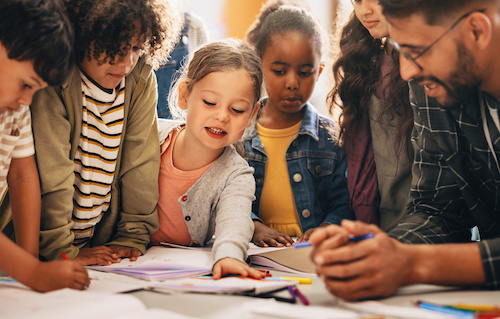Key points:
- Achievement gains are still not quite back to pre-pandemic levels
- The average student needs roughly an additional 4.1 months of school to catch up to pre-COVID levels in reading and 4.5 months in math
- See related article: Finding the learning loss data needed to drive learning recovery
While students grew academically in the 2022-23 school year, achievement gains fell short of pre-pandemic trends in most grades, with the exception of the youngest students who bucked this trend and made above average achievement gains, according to a new report from nonprofit K-12 assessment and research organization NWEA.
The report is the latest in NWEA’s efforts to track the impact of pandemic disruptions on academic gains and achievement levels for U.S. students using data from the 2022-23 academic year. This analysis provides the most current evidence to help guide recovery efforts and resource allocations in support of schools. While the pandemic is now deemed over, the impacts on students based on two markers, achievement in reading and mathematics, are still apparent.
Using data from 6.7 million U.S. public school students currently in grades 3 – 8, the study examined academic gains in the 2022-23 school year relative to pre-pandemic years. It also tracked the gap in achievement between the COVID year student group compared to their pre-pandemic peers.
Key findings from the study:
- The gap in achievement levels between the COVID cohort and their pre-pandemic peers did not shrink in 2022-23, and in some grades widened slightly.
- With these latest numbers, it’s estimated that most students would now need, on average, an additional 4.5 months of mathematics instruction and 4.1 months of reading instruction to recover in these two subjects.
- All groups showed sluggish achievement gains, but traditionally marginalized students (Black, Hispanic), remain furthest from recovery.
“COVID-19 may no longer be an emergency, but we are very much still dealing with the fallout from the crisis. These data reiterate that recovery will not be linear, easy, or quick and we cannot take our foot off the gas pedal,” said Dr. Karyn Lewis, co-author of the study and director of the Center for School and Student Progress at NWEA. “Disappointing as these results may be, it’s important not to lose sight of the fact that things would likely be so much worse without the enduring work of educators and schools to support students in this moment.”
To help contextualize the scale of the gaps, the report estimated the amount of additional learning that will be required to catch students up to pre-pandemic achievement levels. It stated that the average student would need support and interventions equivalent to an additional 4.1 months of school to catch up to pre-COVID levels in reading and 4.5 months in math. This amount of additional schooling cannot be compressed into a single year or achieved in a short-term intervention but rather will require sustained effort over several years. For traditionally marginalized students, the road ahead is even longer. These estimates are only to return students to pre-pandemic status quo, which does nothing to address the achievement disparities that pre-date the pandemic.
“Pandemic disruptions have been persistent and unprecedented, and, not surprisingly, so have their impacts on student achievement. School and district leaders have been doing a heroic job in identifying local needs and deploying evidence-based strategies to address them. But scaling interventions takes significant time and resources, and we know the hard work of educators often takes years to show up in test results,” said Lindsay Dworkin, SVP of Policy and Government Affairs at NWEA. “One year from the expiration of the federal education relief funds, which have supported so much of their vital efforts thus far, policymakers and leaders throughout the education ecosystem must renew their commitment to recovery. Our students deserve the sustained resources and urgency necessary to ensure they have the opportunity to reach their full potential.”
That urgency for sustained resources is reiterated in a series of recommendations for policy makers and education leaders noted in an NWEA policy brief, released alongside the new research. Recommendations include:
- Using local data to guide recovery and investing in what works. States and districts can set up processes and tools that provide capacity to schools when gathering data and tracking the implementation of interventions.
- Expanding instructional time by deploying evidence-based interventions and programs to the students who still need additional support. Interventions and programs must be scaled to the size of the challenge, and students in need of additional support may require multiple interventions to fully recover from the pandemic’s impacts. State and district leaders can work with schools to develop policies and practices that ensure schools are able to implement interventions efficiently and effectively.
- Communicating the importance of academic recovery, sharing timely and relevant information with families. States, districts and schools can provide families with timely information about their child’s progress and achievement compared to grade-level standards and resources that families can use to support learning recovery at home.
This press release originally appeared online.
Related:
7 strategies to counter student learning loss
3 recommendations from research on COVID learning loss
- 4 ways to encourage play in education - April 25, 2024
- CoSN IT Leader Spotlight: Lisa Higgins - April 25, 2024
- It’s time to pay student teachers - April 25, 2024

